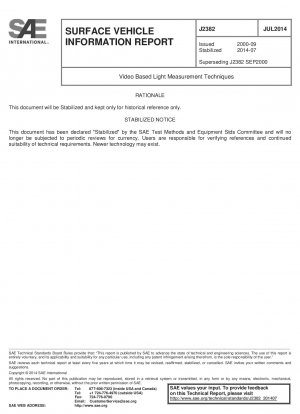SAE J2382-2014
Video Based Light Measurement Techniques
- Standard No.
- SAE J2382-2014
- Release Date
- 2014
- Published By
- SAE - SAE International
- Latest
- SAE J2382-2014
- Scope
- Traditional methods of photometry rely on the use of a goniometer to rotate the test item around two axes at right angles. This method is satisfactory for most situations but has certain disadvantages: a. Point-by-point measurements with a goniometer may be slow. With more advanced requirements@ particularly for headlamps@ where the entire beam pattern is of concern@ isocandela measurements are becoming increasingly needed. Such testing can be very time consuming. b. For production quality assurance@ the speed of a goniometer may not allow testing to keep pace with the production line if a large quantity of lamps must be sampled. c. High Intensity Discharge (HID) lamps are becoming commonly used. Such lamps are orientation sensitive@ changing in both lumen output and intensity distribution when tilted. This can introduce significant inaccuracies in test results when testing is performed using a goniometer. There is a need for alternative test techniques which can achieve very high speed data acquisition@ the capture of full isocandela distribution@ and the elimination of lamp tilting. This SAE Informational Report describes fundamentals of video-based testing to address these concerns. Further information is required to provide all details needed to set up a laboratory using these techniques. With the video-based system@ the lamp is fixed in position and aimed at a receiving screen. A camera@ of particular type and grade@ views the screen and is able to perform measurement of the reflected light (luminance) at each point on the screen. Proper calibration of the system can provide the luminous intensity distribution of the light under test from the measured luminance values. Numerous factors must be taken into account to produce an accurate measurement system. Under controlled conditions@ it has been shown that the system can produce measurement of absolute intensity distributions with good accuracy. (Reference 2.1.1 and 2.1.2.) The great advantage of this form of photometry is its extremely high speed@ allowing the collection of isocandela diagrams in less than one minute. There are some accompanying disadvantages which are discussed later. This document describes the basic techniques and the controls which are necessary for accuracy. Comments are also provided comparing video based technology to conventional goniometer methods. Background and History??The measurement of entire light distributions became a topic of research in the 1960's@ when film cameras were used to perform photometry. (Reference 2.1.3.) Groundwork was laid which suggested that photographic photometry would be a viable technique if the chief source of the problem@ the film itself@ could be replaced by a more stable and reliable means of collecting the image. With the advent of the Charge Coupled Device@ (CCD)@ most of the problems of the film cameras are removed. To produce an accurate system of photometry@ however@ it is essential to understand the characteristics of CCD camera systems. Proper calibration methods must be applied and controls must be exercised to ensure accuracy.
SAE J2382-2014 history
- 2014 SAE J2382-2014 Video Based Light Measurement Techniques
- 2000 SAE J2382-2000 Video Based Light Measurement Techniques
